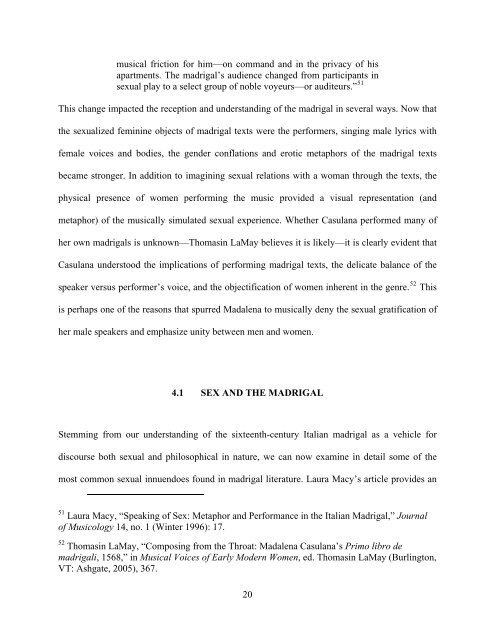Download - D-Scholarship@Pitt - University of Pittsburgh
Download - D-Scholarship@Pitt - University of Pittsburgh
Download - D-Scholarship@Pitt - University of Pittsburgh
You also want an ePaper? Increase the reach of your titles
YUMPU automatically turns print PDFs into web optimized ePapers that Google loves.
musical friction for him—on command and in the privacy <strong>of</strong> his<br />
apartments. The madrigal’s audience changed from participants in<br />
sexual play to a select group <strong>of</strong> noble voyeurs—or auditeurs.” 51<br />
This change impacted the reception and understanding <strong>of</strong> the madrigal in several ways. Now that<br />
the sexualized feminine objects <strong>of</strong> madrigal texts were the performers, singing male lyrics with<br />
female voices and bodies, the gender conflations and erotic metaphors <strong>of</strong> the madrigal texts<br />
became stronger. In addition to imagining sexual relations with a woman through the texts, the<br />
physical presence <strong>of</strong> women performing the music provided a visual representation (and<br />
metaphor) <strong>of</strong> the musically simulated sexual experience. Whether Casulana performed many <strong>of</strong><br />
her own madrigals is unknown—Thomasin LaMay believes it is likely—it is clearly evident that<br />
Casulana understood the implications <strong>of</strong> performing madrigal texts, the delicate balance <strong>of</strong> the<br />
speaker versus performer’s voice, and the objectification <strong>of</strong> women inherent in the genre. 52 This<br />
is perhaps one <strong>of</strong> the reasons that spurred Madalena to musically deny the sexual gratification <strong>of</strong><br />
her male speakers and emphasize unity between men and women.<br />
4.1 SEX AND THE MADRIGAL<br />
Stemming from our understanding <strong>of</strong> the sixteenth-century Italian madrigal as a vehicle for<br />
discourse both sexual and philosophical in nature, we can now examine in detail some <strong>of</strong> the<br />
most common sexual innuendoes found in madrigal literature. Laura Macy’s article provides an<br />
51 Laura Macy, “Speaking <strong>of</strong> Sex: Metaphor and Performance in the Italian Madrigal,” Journal<br />
<strong>of</strong> Musicology 14, no. 1 (Winter 1996): 17.<br />
52 Thomasin LaMay, “Composing from the Throat: Madalena Casulana’s Primo libro de<br />
madrigali, 1568,” in Musical Voices <strong>of</strong> Early Modern Women, ed. Thomasin LaMay (Burlington,<br />
VT: Ashgate, 2005), 367.<br />
20















